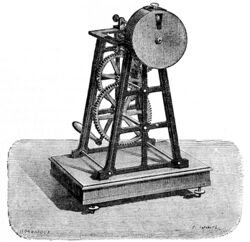Physics:Phosphoroscope
A phosphoroscope is piece of experimental equipment devised in 1857 by physicist A. E. Becquerel to measure how long it takes a phosphorescent material to stop glowing after it has been excited.[1]
It consists of two rotating disks with holes in them. The holes are arranged on each disk at equal angular intervals and a constant distance from the centre, but the holes in one disk do not align with the holes in the other. A sample of phosphorescent material is placed in between the two disks. Light coming in through a hole in one of the discs excites the phosphorescent material which then emits light for a short amount of time. The disks are then rotated and by changing their speed, the length of time the material glows can be determined.
References
- ↑ "Natural Philosophy Collection. Bequerel's [sic] Phosphoroscope". University of Aberdeen. http://homepages.abdn.ac.uk/npmuseum/selected.php?id=31. Retrieved 2014-12-16.
External links
 |


